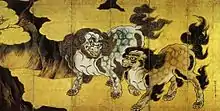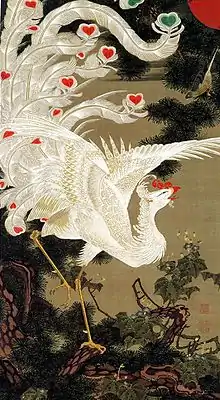Museum of the Imperial Collections
The Museum of the Imperial Collections Sannomaru-Shōzōkan (三の丸尚蔵館) is located on the grounds of the East Garden of Tokyo Imperial Palace.[1] It showcases a changing exhibition of a part of the imperial household treasures.
三の丸尚蔵館 | |
 | |
 Location of Museum of the Imperial Collections in Japan | |
| Established | 1993 |
|---|---|
| Location | 1-1 Chioyoda, Chiyoda-ku, Tokyo, Japan 100-0001 |
| Coordinates | 35.686302°N 139.759247°E |
| Type | Art museum |
| Collection size | ca. 9,500 pieces |
| Owner | Japanese Imperial Household Agency |
| Public transit access | Ōtemachi Station (Tokyo), Tokyo Metro Toei Subway |
| Website | (in Japanese) |
History
The Museum of the Imperial Collections was conceived during the change from the Shōwa period (1926 – 1989) to the Heisei period (1989 – 2019) . The Imperial family donated 6,000 pieces of art to the Japanese government in 1989. Many pieces were created by Imperial Household Artists. The museum was opened in 1993 for the study and preservation of the art collection. The collection was further enlarged by the donation of the art collection of Prince Chichibu (1902 – 1953) in 1996, the collection of Kikuko, Princess Takamatsu (1911 – 2004) in 2005, and the collection of Prince Mikasa family in 2014.[1]
The number of items in the collection is 9,800 at present, but the exhibition room is a small room of 160 square meters and the storage room is small. Therefore, the existing museum will be rebuilt and the exhibition room will be expanded to 1,300 square meters. The construction is scheduled to be completed in 2025.[2]
Selected artists


Although the museum houses many masterpieces, none of them are designated as National Treasure or Important Cultural Property because cultural properties owned by the Imperial Family or the Imperial Household Agency (Cultural properties donated to the nation by the Imperial family) are not subject to the Law for the Protection of Cultural Properties of Japan.[3]
Nihonga
- Kaihō Yūshō (1533–1615)
- Kanō Eitoku (1543–1590)
- Iwasa Matabei (1578–1650)
- Kanō Tan'yū (1602–1674)
- Kanō Tsunenobu (1636–1713)
- Tawaraya Sōtatsu (early 17th century)
- Maruyama Ōkyo (1733–1795)
- Itō Jakuchū (1716–1800)
- Sakai Hōitsu (1761–1828)
- Hokusai (1760–1849)
Calligraphy
- Wang Xizhi (303 – 361)
- Kūkai (774 – 835)
- Ono no Michikaze (894 – 966)
- Fujiwara no Sukemasa (944 – 998)
- Fujiwara no Kintō (966 – 1041)
- Fujiwara no Yukinari (972 – 1027)
- Minamoto no Shunrai (1055–1129)
- Fujiwara no Teika (1162–1241)
Modern Nihonga
- Yokoyama Taikan (1868–1958)
- Kanzan Shimomura (1873–1930)
- Tomioka Tessai (1837–1924)
- Takeuchi Seihō (1864–1942)
- Kawai Gyokudō (1873–1957)
- Uemura Shōen (1875–1949)
Sculptures and crafts
- Kawanobe Itcho (1831–1910)
- Miyagawa Kōzan (1842-1916)
- Asahi Gyokuzan (1843–1923)
- Unnno Shomin (1844–1915)
- Namikawa Yasuyuki (1845–1927)
- Namikawa Sōsuke (1847–1910)
- Ishikawa Komei (1852–1913)
- Takamura Kōun (1852–1934)
References
- "Sannomaru Shozokan (The Museum of the Imperial Collections)". Tokyo, Japan: Imperial Household Agency. c. 2020. Retrieved July 3, 2020.
- 皇居資料館、出国税で拡張 「三の丸尚蔵館」外国人客増目指し Mainichi Shinbun January 13, 2019
- 宮内庁三の丸尚蔵館の今後の保存・公開の在り方に関する提言. p.7 Imperial Household Agency